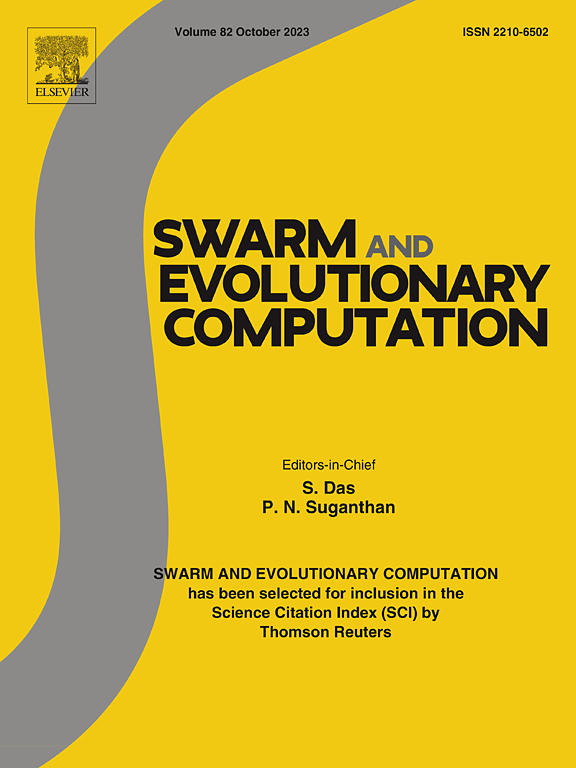动态多目标优化的自适应混合响应机制及其在多机器人任务分配中的应用
IF 8.5
1区 计算机科学
Q1 COMPUTER SCIENCE, ARTIFICIAL INTELLIGENCE
引用次数: 0
摘要
多机器人任务分配(MRTA)中任务需求的动态变化和机器人状态的实时波动增加了算法设计的复杂性。提出了一种基于混合响应机制的动态多目标MRTA自适应多目标进化算法(AMOEAD-HRM),通过创新机制解决环境不确定性问题。AMOEAD-HRM提出了一种基于GNG的预测响应机制,利用生长神经气体(growth Neural Gas, GNG)网络来模拟任务和机器人状态的时变性质。与固定架构预测器不同,GNG捕获数据拓扑结构来构建自适应预测模型,通过迭代优化网络拓扑来动态调整波动和不确定性。这使得在没有先验分布假设的情况下有效地表征复杂的时间模式,为预测动态变化提供了坚实的基础。为了提高响应能力,该算法将基于记忆的响应机制与高斯多项式混合突变策略相结合。动态自适应权值调整策略根据环境变化程度选择最优响应机制,平衡预测精度和实时适应性,提高系统的鲁棒性和灵活性。在19个基准问题上的实验验证表明了AMOEAD-HRM的优越性。在动态场景下,它的响应速度比DNSGA-II快46.1%。在高动态下,其溶液集的MHV比DNSGA-II高3.4%。MHV比SGEA高0.34%,变化适中。本文章由计算机程序翻译,如有差异,请以英文原文为准。
Adaptive hybrid response mechanism for dynamic multi-objective optimization and its application in multi-robot task allocation
The dynamic changes in task requirements and real-time fluctuations in robot states in multi-robot task allocation (MRTA) increase the complexity of algorithm design. This paper presents an Adaptive Multi-Objective Evolutionary Algorithm with Hybrid Response Mechanism (AMOEAD-HRM) for dynamic multi-objective MRTA, addressing environmental uncertainty through innovative mechanisms. AMOEAD-HRM proposes a GNG-based prediction response mechanism, leveraging Growing Neural Gas (GNG) networks to model the time-varying nature of tasks and robot states. Unlike fixed-architecture predictors, GNG captures data topological structures to construct adaptive predictive models, dynamically adjusting to fluctuations and uncertainties by iteratively optimizing network topology. This enables effective characterization of complex temporal patterns without prior distribution assumptions, providing a robust foundation for predicting dynamic changes. To enhance responsiveness, the algorithm integrates a memory-based response mechanism and a Gaussian polynomial mixture mutation strategy. A dynamic adaptive weight adjustment strategy selects optimal response mechanisms according to environmental variation degrees, balancing prediction accuracy and real-time adaptability to improve system robustness and flexibility. Experimental validation on 19 benchmark problems shows AMOEAD-HRM’s superiority. In dynamic scenarios, it responds 46.1% faster than DNSGA-II. Under high dynamics, its solution sets have 3.4% higher MHV than DNSGA-II. With moderate changes, MHV is 0.34% higher than SGEA.
求助全文
通过发布文献求助,成功后即可免费获取论文全文。
去求助
来源期刊

Swarm and Evolutionary Computation
COMPUTER SCIENCE, ARTIFICIAL INTELLIGENCEC-COMPUTER SCIENCE, THEORY & METHODS
CiteScore
16.00
自引率
12.00%
发文量
169
期刊介绍:
Swarm and Evolutionary Computation is a pioneering peer-reviewed journal focused on the latest research and advancements in nature-inspired intelligent computation using swarm and evolutionary algorithms. It covers theoretical, experimental, and practical aspects of these paradigms and their hybrids, promoting interdisciplinary research. The journal prioritizes the publication of high-quality, original articles that push the boundaries of evolutionary computation and swarm intelligence. Additionally, it welcomes survey papers on current topics and novel applications. Topics of interest include but are not limited to: Genetic Algorithms, and Genetic Programming, Evolution Strategies, and Evolutionary Programming, Differential Evolution, Artificial Immune Systems, Particle Swarms, Ant Colony, Bacterial Foraging, Artificial Bees, Fireflies Algorithm, Harmony Search, Artificial Life, Digital Organisms, Estimation of Distribution Algorithms, Stochastic Diffusion Search, Quantum Computing, Nano Computing, Membrane Computing, Human-centric Computing, Hybridization of Algorithms, Memetic Computing, Autonomic Computing, Self-organizing systems, Combinatorial, Discrete, Binary, Constrained, Multi-objective, Multi-modal, Dynamic, and Large-scale Optimization.
 求助内容:
求助内容: 应助结果提醒方式:
应助结果提醒方式:


